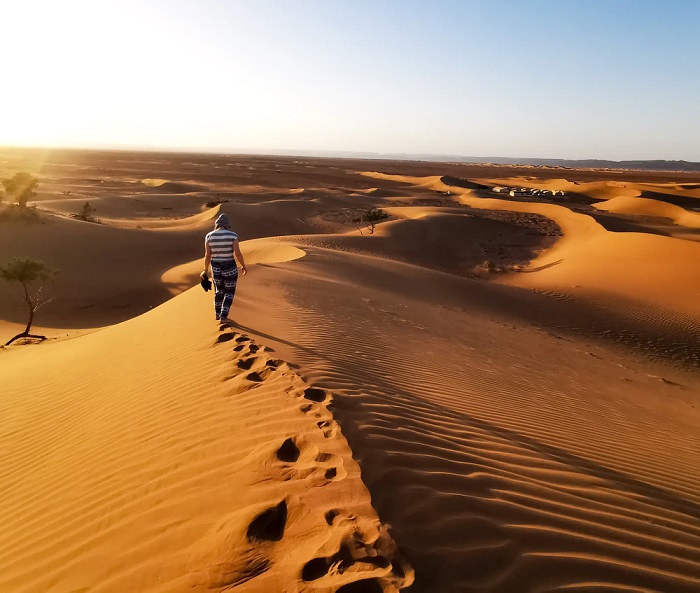Solitude And Primeval Wilderness-Lonely Sand Dunes of Glamis

Formidable turbulence within the earth caused a rise in the area above the ocean, somewhere around 200 million years ago and the ceaseless forces of erosion over countless ages have all had a role to play in sculpting this vast region. The climate in this region has largely been tropical over countless millennia.
But with a shift in the earth’s crust, along the San Andreas Fault, the coastal mountains rose, blocking off the dense moisture-laden air proceeding from the ocean. Around the same time, the interior plains of Southern California sank and declined to result in the formation of a basin otherwise known as the Salton Sink.
Gradually, as the region became arid, many plants and animals were forced to become accustomed to the new environment or face extinction.
The Colorado River meandered through the featureless land, being rhythmically diverted in one or another direction by residual silt deposits following the floods. The river sometimes flowed into the Gulf of California, as it presently does, and at other times turned westward into the Salton Sink. On every occasion that the river flowed into the Salton Sink, a resulting large freshwater lake was formed. Scientists refer to the primordial body of water as Lake Cahulla(ka-WEE-ah). The last lake Cahuilla drenched most parts of the Imperial, Coachella, and Mexicali Valleys until the 1400s.
According to conventional wisdom, the Imperial Sand Dunes were the resultant formation of windblown beach sands blowing eastward from the old lakeshore to their current location in a ceaseless process that continues into eternity. Prevalent winds caused the dunes to drift and move abroad towards the southwest at the rate of approximately one foot per year.
The primary force contouring the dunes is wind, and by understanding the interconnection between the wind and sand, we see that dunes are generally oriented in a perpendicular direction to the wind. As the wind generally blows west to east, it follows a north-south orientation course.
Numerous dune plants are sparsely found and face imminent extinction. As they are peculiar only to this kind of habitat.
Examples include the silver-leaved dune sunflower, Peirson’s milkyetech, and the Giant Spanish needle. Sandfood, which is a plant, that is parasitic by nature, obtains its nutrition by tapping the roots of neighbouring desert shrubs. It is an unusual dune resident which appears on the surface of each spring. Fund-raising from a wide range of sources such as the State OHV Fund helps in the monitoring of plant and other wildlife species at close quarters. The dunes are engineered to provide recreational opportunities and an expedient natural environment and ecosystem for delicate species.
Large open pockets virtually free of the dune formation are situated in an easterly direction of the dune system. Runoff from summer and autumn rains drains into these relatively stable low-lying areas in the mountains to the east. Found here are desert woodland species such as ironwood, paloverde, honey mesquite, desert willow, and other trees and shrubs. Most gigantic wildlife species seek the cover of dense vegetation along the dune periphery, though mammals such as coyote and mule deer are intermittently found traversing across the dune system. Rabbits, ground squirrels, and a variety of birds, lizards, and insects are spotted throughout the dunes.
One of the most commonly found denizens of the desert is the Gecko Campground otherwise also called the Banded Gecko. This miniature lizard has smooth skin which gives it the appearance of a creature from the marshes or bog. It has unique scalloped eyelids that interlock to protect the eyes from the sand. Its long tongue can be used to lick its eyes clean whenever necessary. They mostly hibernate and are nocturnal. One might discern the mating call of a gecko on a tranquil spring evening. These are a rare species endowed with a voice with the purport of making a match. It is worthwhile to Visit Glamis Dunes.
The windward side of the dune is west because that is the side the wind blows against. The side away from the wind is its leeward side. The windward slope takes on the shape of a curve resulting from grains of sand being blown upwards by the wind. The sand grains landing atop the leeward side, lend acclivity to the slope. This upper steep portion is called the slip face as flakes of sand slide down its side. The more gargantuan the dune the more massive is its slip face. Two of the largest and best known are Competition hill and the Brawley slide. The slip face will be the steepest just after gusty gales of a windstorm. There have occurred many dune vehicle accidents resulting from failure to predict the slope. On larger dunes, a vehicle may fall downwards 50 feet or more below landing in the snow underneath often resulting in human tragedies.